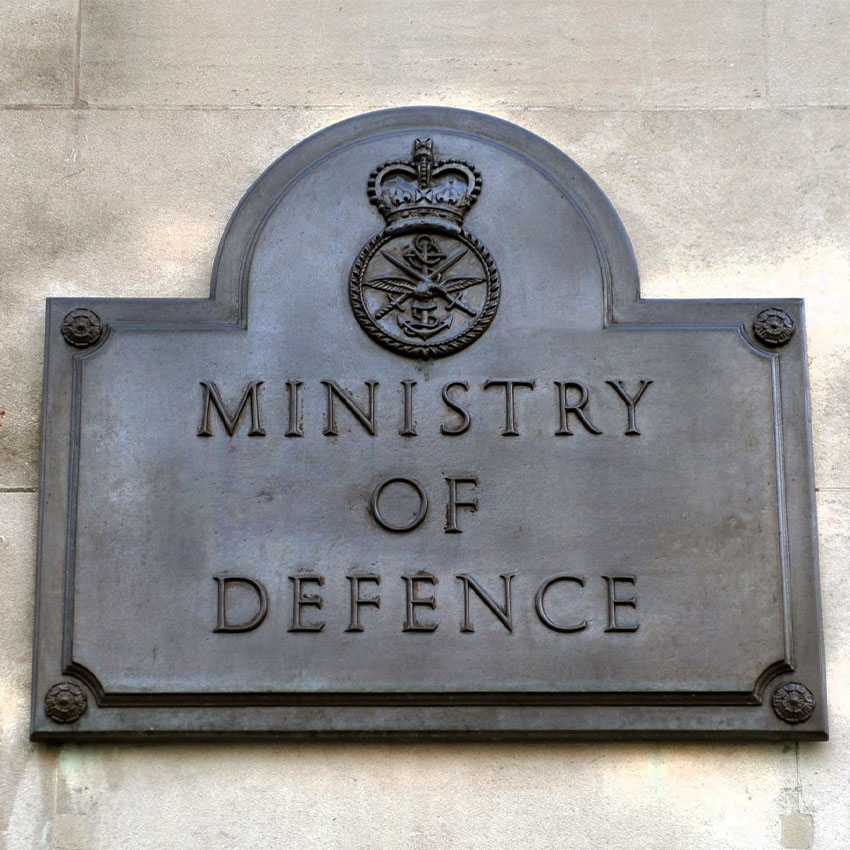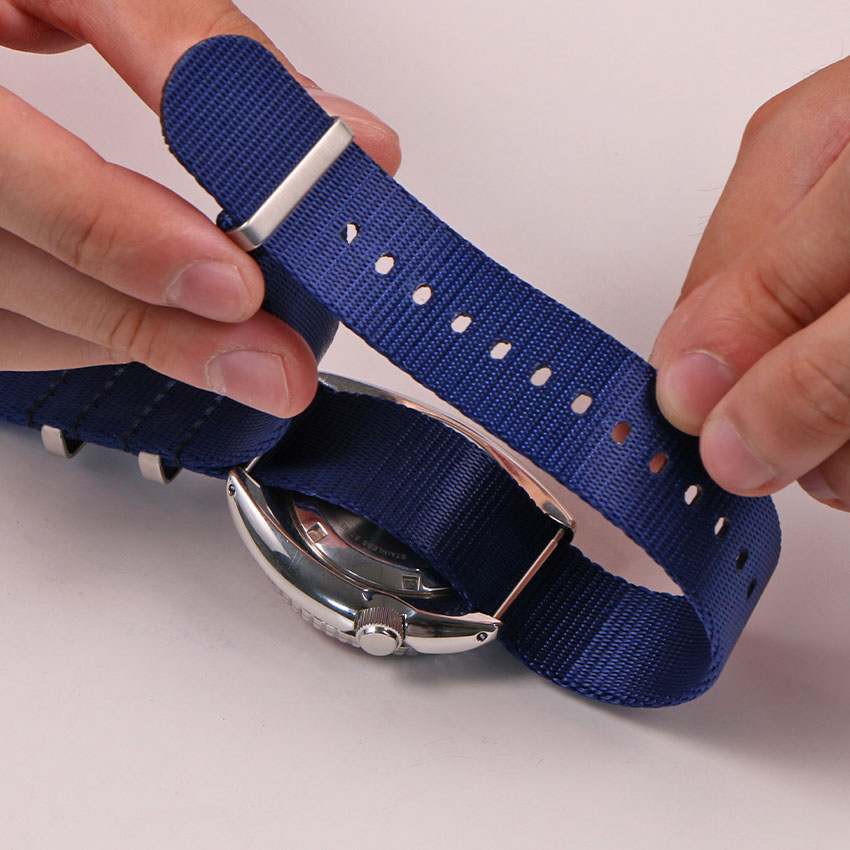Camo print, cargo pants, combat boots — The military has long been a source for fashion trends, with top designers transforming what was once utilitarian, standard-issue gear into must-haves for the style-savvy. Take one look at the abundance of military-inspired timepieces available today, and it’s obvious that the watch world has wholeheartedly embraced this look and made it their own. From Air Force pilot watches to Navy diving watches, any serious watch enthusiast likely has at least one military-type timepiece in their collection.

But military inspiration doesn’t stop at the case or dial. It has also heavily influenced one of the most crucial watch accessories: the watch strap. Among all the variations—Zulu straps, camouflage prints, the Bund strap—none have reached the popularity and staying power of the NATO watch strap.
What Is a NATO Watch Strap?
So, what is a NATO watch strap exactly? Originally created for military use, a NATO strap is a one-piece design that slides through the spring bars of a watch, with a secondary shorter strap that loops behind the watch case. This design prevents the watch from falling off if a spring bar fails, offering added security and reliability. It’s simple, secure, and now incredibly stylish.

The G10 NATO Strap
In 1973, the British Ministry of Defense (MOD) added to their catalog a new standard-issue item named “Strap, Wrist Watch.” These wristwatch straps, later nicknamed the G10 NATO strap (after the G10 requisition form), were 20mm wide, made from grey nylon, and came with chrome-plated brass hardware.

The strap was constructed from two pieces of nylon fabric — a longer strap to wrap around the wrist and a shorter one to secure the watch case. This design gave the NATO strap its iconic structure and function.
The “NATO” name came later, referencing the 13-digit NATO Stock Number (NSN) used for military inventory. Since then, the G10 NATO strap has evolved from a piece of military equipment into a fashion and functional essential for watch lovers worldwide.
The James Bond NATO Strap
When Sean Connery sported his Rolex Submariner in 1964’s ‘Goldfinger’, fans noticed something new — a striped nylon strap that contrasted the leather bands of previous films. Today, this design is known (somewhat inaccurately) as the NATO Strap ‘James Bond’ version.

Though the actual NATO watch band wasn’t officially introduced until years later, modern versions of the James Bond NATO strap often feature the iconic black and grey stripes. This style has become synonymous with cool, classic spy vibes and is one of the best NATO watch strap options for those seeking vintage appeal with modern reliability.
Today’s NATO Strap
Fast forward to today, and the NATO watch strap has become a staple in every watch lover’s toolkit. No longer restricted to the drab “Admiralty Grey,” NATO straps are now available in an endless array of colors, materials, and configurations — from bold neon to earthy camo prints, and even leather NATO straps for a dressier look.

Other modern options include:
- Classic NATO bands made from durable nylon including adjustable and clasp variations.
- Single pass one piece watch straps and minimalist one piece watch bands that mimic the original military design
- 2 piece nylon watch straps and that offer a less bulky fit
- More size variations than the original NATO watch strap in 20mm including anywhere from 16mm up to over 24mm for larger watches.
These days, you’re just as likely to see a NATO strap on a luxury Swiss watch as on a military-inspired field watch. The versatility and affordability of these straps make them ideal for swapping based on your outfit or mood.
Some common NATO strap FAQ:
What is a NATO Strap vs. a Zulu Strap?
The terms NATO strap vs. Zulu strap are often used interchangeably, but there are key differences. NATO straps typically have a thinner profile, a two-strap design for added security, and smaller buckles while Zulu straps usually feature thicker nylon, beefier hardware, and come in two-ring or five-ring configurations. Both styles offer durability and rugged appeal, so your choice might come down to wrist size, comfort, or personal style preferences!

How Long Do NATO Straps Last?
The answer depends on usage, material, and quality. A high-quality nylon watch strap can last several years with regular wear, while leather NATO straps might develop a unique patina over time. Regular cleaning and proper storage will extend the lifespan of any strap.
How to put a NATO Strap on a Watch?
How to put a NATO strap on a watch is one of the most asked questions by new watch enthusiasts and we’ve put together this quick guide to help!

NATO watch bands pack a ton of military history, making them a perfect pairing for any field watch. However, due to their versatility, comfort, and practicality they are worn with a wide array of watches today. These often budget-friendly straps offer easy customization, compatibility with nearly any watch and a secure, rugged design.
From its military roots to being at the forefront of modern watch styles, the NATO watch strap has more than earned its iconic status. Whether you’re after an original G10 NATO-style strap, a sleek 2 piece nylon watch band, or even the legendary James Bond NATO strap, there’s truly a NATO strap style for everyone.
So the next time you’re looking to refresh your wrist game, consider the humble yet mighty NATO watch band — it’s not just a strap, it’s a legacy.
Let us know below what your favorite NATO-style strap is or the watch you like to pair it with!







Comments
Just note the NATO strap was never designed with spring bars in mind. All of the watches it was designed for have solid steel soldered in place bars. The spring bar thing is just a fortunate coincidence and was never intended or even thought of.
Great article about NATO straps.
Two issues I have with NATO straps.
First, there is ordinarily extra length on the “tail” end of the nylon strap which requires that the tail end be doubled up and tucked under the nearest keeper ring. This is bulky and clumsy (to my eye), and doesn’t get along well with shirt cuffs.
Second, a nylon strap isn’t generally compatible with a deployant clasp which many folks like me find it functionally convenient, comfortable and aesthetically desirable on their straps or bands/bracelets.
There are two major sources which offer nylon and/or elastomer nylon straps but which are NOT based upon the standard pin buckle retention concept. Both are attractive, comfortable, well designed and there’s no excess tail length to deal with.
The major sources of these alternatives are the Zuludiver Octopod series and Erika’s Original MN straps.
***I would love to see StrapsCo (a company that I am particularly fond of and which U.S. based) offer these types of straps or something along these lines as an alternative for those interested..
Just my 2 cents.
Thanks.
The main reason I prefer pass-through nylon straps on my field watches is practical: if you snag the watch on a pack strap and pop a spring bar pin, the continuous design of the strap holds the watch. And of you are working in dirty sweaty places, you can take off the strap and wash it in soap and water.
This was a really fun read! Super appreciated.